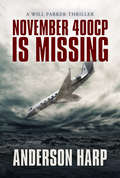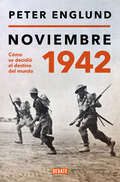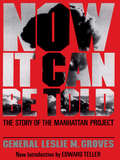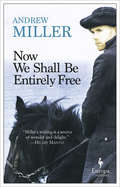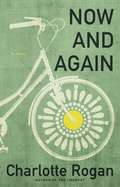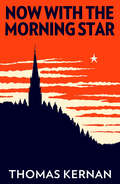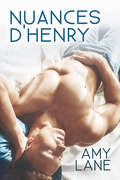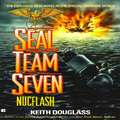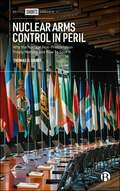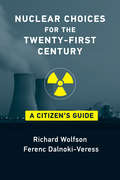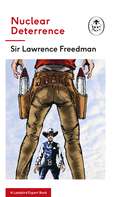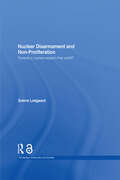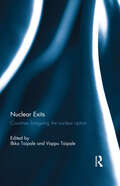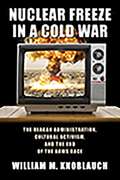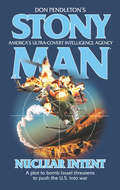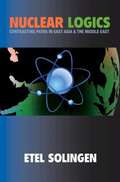- Table View
- List View
November 400CP Is Missing (A Will Parker Thriller #6)
by Anderson HarpSLIPPERY SLOPE The PT Chevron Pacific Gulfstream banks towards the north after lifting off from the international airport at Kuala Lumpur. The oil-exploration team has reason to celebrate: The new oil field outside of Minas will be the biggest reserve in the history of Indonesia. And the country desperately needs it. The team breaks open the fifty-year-old bottle of scotch they&’ve been saving for just this moment. But in the next moment, the jet drops abruptly, like a rock, then turns sharply west on a path similar to that of a well-known commercial airliner from the recent past, descends through radar coverage . . . and disappears. Decorated Marine colonel and small-town Georgia D.A. Will Parker has nothing to do with Chevron Pacific—until the wife of a former Marine buddy calls. She understands that her husband, who had been working for Chevron, is gone. But she wants answers, and the FBI and CIA are of little help. It&’s a request Will can&’t refuse. Will&’s contact on the ground is Retno Karims, a sharp, multilingual, former Miss Indonesia who speaks Bahasa Indonesian, Chinese, and Javanese. She also happens to be from Banda Aceh. Rumor has it that the terrorist group Laskar Mujahidin has reawakened and is operating somewhere in Banda Aceh on the northern point of Sumatra. No one doubts they&’re involved in downing the oil-company jet. Then again, no one believes any proof will stick, even if authorities locate the wreckage. Parker believes otherwise . . .Praise for RETRIBUTION&“Tense and authentic—reading this book is like living a real life mission.&” —Lee Child&“I seldom come across a thriller as authentic and well‑written as Retribution. Andy Harp brings his considerable military expertise to a global plot that&’s exciting, timely, and believable . . . to say that I&’m impressed is an understatement.&”—David Morrell, New York Times bestselling author of The Protector&“Retribution is a stunner: a blow to the gut and shot of adrenaline. Here is a novel written with authentic authority and bears shocking relevance to the dangers of today. It reminds me of Tom Clancy at his finest.&”—James Rollins, New York Times bestselling author of Bloodline&“Outstanding thriller with vivid characters, breakneck pacing, and suspense enough for even the most demanding reader. Harp writes with complete authenticity and a tremendous depth of military knowledge. A fantastic read—don&’t miss it!&”—Douglas Preston, #1 bestselling author of Impact
Noviembre 1942: Una historia íntima del momento decisivo de la Segunda Guerra Mundial
by Peter EnglundEl académico sueco Peter Englund trenza con maestría vidas y testimonios reales en este relato coral sobre el fatídico noviembre de 1942, que cambió el rumbo de la Segunda Guerra Mundial. La intrahistoria del mes más importante de la Segunda Guerra Mundial, contada exclusivamente a partir de los diarios, las cartas y las memorias de las personas que lo vivieron.A primeros de noviembre de 1942, parecía que las potencias del Eje todavía podían ganar la Segunda guerra mundial; antes de terminar ese mes era obviamente una cuestión de tiempo que fueran derrotadas. Entremedias había pasado el-Alamein, Guadalcanal, los desembarcos aliados en el norte de África, la retirada japonesa de Nueva Guinea y el avance soviético que rodeaba al Sexto Ejército alemán en Estalingrado. Puede que hayan sido los treinta días más importantes del siglo XX. En esta innovadora y fascinante obra, el sueco Peter Englund ha concentrado un momento histórico clave en su componente fundamental: la experiencia humana. Este relato está basado solo en los textos escritos tanto por soldados como por civiles, un recurso asombroso y profundamente humano. En treinta días memorables conoceremos entre otros a un soldado de infantería soviético en Estalingrado, un piloto estadounidense en Guadalcanal, un conductor de camiones italiano en el desierto del norte de África, un partisano en los bosques de Bielorrusia, un artillero en un bombardero británico, una niña de 12 años en Shanghái, una ama de casa en Long Island, un marinero chino naufragado, un prisionero en Treblinka, una «mujer de consuelo» coreana en Mandalay, Albert Camus, Vera Brittain... así hasta cuarenta personajes.Desde la publicación del anterior libro del autor, La belleza y el dolor de la batalla, que lanzaba una mirada similar a la primera guerra mundial, no ha aparecido un libro de historia tan fascinante. La crítica ha dicho:«Para educar a la mayoría, está magistralmente construido; como ciencia para la mayoría, es probablemente único; un logro de alcance internacional. Como literatura, es un libro que da qué pensar profundamente, lo que hace que el lector mire hacia dentro, hacia su propio tiempo».Expressen «Un coro poderoso y conmovedor, y de trasfondo el propio autor siempre presente como un espléndido guía, un maestro de la polifonía y la ambigüedad».Dagens Nyheter«Es como si toda la destreza de escritura de Englund se hubiera liberado. [...] Noviembre 1942 lo convierte en uno de los autores más importantes del país, de entre todas las categorías y de todos los tiempos».Sydsvenskan «Englund demuestra cómo la guerra redobla nuestro presente, lo hace vibrar. [...] Lo que de verdad vale la pena de la epopeya Noviembre de Englundes cómo el autor se las apaña para evocar el día a día de unos sucesos extraordinarios».Svenska Dagbladet «Un recordatorio brillante, en nuestra época, de cuán destructiva es la guerra en todos los niveles».Göteborgs-Posten
Now Hear This!: Ships of the U.S. Navy in World War II
by John J. MotleyNow Hear This!, first published in 1947, is an account of the combat actions of representative ships of the U.S. Navy during World War II in all theaters of the War. Included are accounts of historic battleships such as the Missouri and Iowa, aircraft carriers such as the Hornet and Saratoga, cruisers, destroyers, and submarines, as well as the exploits of lesser known, but vital to the war effort, merchant marine ships, transport ships, landing craft, tender ships, store ships, PT boats, hospital ships, and even ‘lowly’ tugs. The accounts, prepared from official U.S. Navy records and from interviews with crew members, are succinct, yet authoritative, making Now Hear This! an invaluable reference to the military scholar or anyone interested in learning more about the U.S. naval fleet, and the service, drama, and hardships the ships and their crews faced as they battled enemy ships, submarines, aircraft, mines, sharks, violent weather, and more. Included is an Appendix listing ships receiving various commendations, a list of naval vessels lost during the war, and a chronology of important Second World War naval events. Also included are 16 pages of photographs.
Now It Can be Told: The Story of the Manhattan Project
by Edward Teller Leslie R. Groves"General Leslie Groves and J. Robert Oppenheimer were the two men chiefly responsible for the building of the first atomic bomb at Los Alamos, code name ""The Manhattan Project. "" As the ranking military"
Now We Shall Be Entirely Free
by Andrew MillerA British soldier flees to the Hebrides for reprieve from war while something else hunts for him in this historical thriller by the author of The Crossing.When Cap. John Lacroix returns home from Spain, wounded, unconscious, and alone, he believes that he has seen the worst of what men may do. It is 1809, and in England’s wars against Napoleon, the Battle of Corruna stands out as a humiliation: a once-proud army forced to retreat, civilized men reduced to senseless acts of cruelty.Slowly regaining his health, Lacroix journeys north to the misty isles of Scotland with the intent of forgetting the horrors of the war. Unbeknownst to him, however, something else has followed him back from the war—something far more dangerous than a memory . . .A New York Times Notable Book of 2019“Miller’s writing is a source of wonder and delight.” —Hilary MantelPraise for New We Shall Be Entirely Free“Mr. Miller strikes an impressive balance between adventure and atmosphere.” —The Wall Street Journal“Miller acutely imagines the war-scarred psychology of his characters . . . and uses the historical setting to great advantage.” —TheNew Yorker“Miller is in fine form here, mixing an unforgettable cat-and-mouse chase with a moving love story.” —Kirkus Reviews
Now and Again
by Charlotte RoganA provocative novel about the fallout from a search for truth by the author of the national bestseller The Lifeboat.For Maggie Rayburn--wife, mother, and secretary at a munitions plant--life is pleasant, predictable, and, she assumes, secure. When she finds proof of a high-level cover-up on her boss's desk, she impulsively takes it, an act that turns her world, and her worldview, upside down. Propelled by a desire to do good--and also by a newfound taste for excitement--Maggie starts to see injustice everywhere. Soon her bottom drawer is filled with what she calls "evidence," her small town has turned against her, and she must decide how far she will go for the truth. For Penn Sinclair--Army Captain, Ivy League graduate, and reluctant heir to his family's fortune--a hasty decision has disastrous results. Home from Iraq and eager to atone, he reunites with three survivors to expose the truth about the war. They launch a website that soon has people talking, but the more they expose, the cloudier their mission becomes. Now and Again is a blazingly original novel about the interconnectedness of lives, the limits of knowledge, and the consequences of doing the right thing.
Now the Hell Will Start
by Koerner Brendan I.An epic saga of hubris , cruelty, and redemption, Now the Hell Will Start tells the remarkable tale of the greatest manhunt of World War II. Herman Perry, besieged by the hardships of the Indo-Burmese jungle and the racism meted out by his white commanding officers, found solace in opium and marijuana. But on one fateful day, Perry shot his unarmed white lieutenant in the throes of an emotional collapse and fled into the jungle. Brendan I. Koerner spent nearly five years chasing Perry's ghost to the most remote corners of India and Burma. Along the way, he uncovered the forgotten story of the Ledo Road's GIs, for whom Jim Crow was as powerful an enemy as the Japanese-and for whom Herman Perry, dubbed the jungle king, became an unlikely folk hero. .
Now the War Is Over: Britain, 1919–1920
by Daniel Weinbren Simon FowlerHow did Britain respond to the momentous events of 1919 and 1920 as it adjusted to peace after four years of war? What were the challenges the British people faced and how did they cope with the profound changes that confronted them? Now the War Is Over seeks to answer these questions. It looks at what happened in every sphere of life and it shows how, even today, we are still dealing with the consequences of those years of transition.Across Europe there were revolutions, a war for independence occurred in Ireland, and on mainland Britain there were widespread race riots. However, most servicemen simply wanted to come home to their families and a secure job. Some hoped for a return to the certainties of a pre-war world, but this was impossible too much had happened. As they explore the troubled state of Britain immediately after the war Simon Fowler and Daniel Weinbren give us a fascinating insight into how the global conflict changed the direction of the nation.
Now with the Morning Star
by Thomas KernanNow with the Morning Star, first published in 1944, is a well-crafted account of life in Germany during World War II, beginning with life in a peaceful monastery. Soon, however, the Nazis arrive and one of the monks is arrested and subsequently interned in a camp. American author Thomas Kernan, himself a prisoner of the Germans, wrote the book in 1943-44 during his own internment in a camp near Stuttgart. The book portrays life under Nazi-ruled Germany as well as the monk’s struggle to survive.As author Kernan states in the book’s introduction: “This book was written between November 1943 and March 1944, the last months of my internment at Baden-Baden in Germany. Thanks to the fact that I was repatriated with diplomatic immunity, I was able to bring the manuscript out of Germany with me, and home to America on the S.S. Gripsholm.”
Nuances d'Henry: Shades Of Henry Fr (Une histoire de la Piaule #1)
by Amy LaneUne tentative d&’acte d&’intégrité coûte tout à Henry Worrall – sa carrière militaire, sa famille et le petit ami secret qui l&’a gardé piégé pendant onze ans. Désespéré, Henry arrive à la porte de son frère, et on lui offre un endroit où vivre et un travail comme homme à tout faire dans une piaule pour jeunes stars du porno.Le passé de Lance Luna lui a donné des raisons de faire du porno, mais tandis qu&’il poursuit son internat dans un hôpital local, elles ressemblent désormais plus à des excuses. Il a l&’argent pour déménager de la piaule et vivre sa propre vie – mais qui a besoin d&’intimité quand on s&’occupe d&’une bande de jeunes hommes qui pensent que travailler du pénis fait d&’eux des adultes ?Lance s&’inquiète que Henry ne s&’intègre pas, mais celui-ci a un faible pour les jeunes hommes perdus et la manière pour les aider. Alors que Lance et Henry trouvent leur rythme en tant que mères poules, un meurtre et les fantômes du passé violent d&’Henry font irruption dans leurs vies. Lance sait que celui-ci n&’est pas capable de meurtre, mais est-il capable de prendre soin du cœur de Lance ?
Nucflash (Seal Team Seven, #3)
by Keith DouglassPart of Third Platoon, SEAL Team Seven, is in Great Britain participating in a training exchange program with the British SAS when an international terrorist organization hijacks an oil platform in the North Sea. The terrorists claim to have a nuclear device which they will detonate if their demands are not met. The remainder of Third Platoon quickly arrives on the scene and the SEALS assume the primary responsibility for reclaiming the oil platform, freeing the hostages and finding and neutralizing the nuclear device.
Nuclear Arms Control in Peril: Why the Nuclear Non-Proliferation Treaty Matters and How to Save It
by Thomas D. GrantIn this book, a former US Department of State senior arms control official critically analyses two pivotal nuclear arms control treaties: the established Treaty on the Non-Proliferation of Nuclear Weapons (NPT) and the rising Treaty on the Prohibition of Nuclear Weapons (TPNW). The book offers a concise and critical analysis of the two, illuminating both their strengths and shortcomings. The author acknowledges the idealistic goal of the TPNW but argues that its immediate abolitionist stance lacks a roadmap for achievement. Instead, the book advocates realistic progress within the NPT framework. It provides twelve key negotiation topics for fostering meaningful dialogue among nuclear-weapon states, while emphasizing the urgency of concrete action in a world facing growing nuclear threats.
Nuclear Choices for the Twenty-First Century: A Citizen's Guide
by Richard Wolfson Ferenc Dalnoki-VeressAn authoritative and unbiased guide to nuclear technology and the controversies that surround it.Are you for nuclear power or against it? What's the basis of your opinion? Did you know a CT scan gives you some 2 millisieverts of radiation? Do you know how much a millisievert is? Does irradiation make foods safer or less safe? What is the point of a bilateral Russia-US nuclear weapons treaty in a multipolar world? These are nuclear questions that call for nuclear choices, and this book equips citizens to make these choices informed ones. It explains, clearly and accessibly, the basics of nuclear technology and describes the controversies surrounding its use.
Nuclear Conundrum of Iran and North Korea: From Proliferation Crisis to Non-Proliferation Promise?
by Hina PandeyThis book examines Iran and North Korea from a non-proliferation lens. It highlights how these two countries stand out as nuclear challenges vis-à-vis the NPT and unpacks their nuclear history, recent developments, nuclear resolve in the times of the pandemic and future challenges in a comprehensive manner. It shows how these two issues remain similar, distinguished, dynamic but static so far progress on non-proliferation is concerned. The book will be a valuable read for students, scholars, academicians, policy practitioners and anyone invested and interested in nuclear issues. Print edition not for sale in South Asia (India, Sri Lanka, Nepal, Bangladesh, Pakistan and Bhutan)
Nuclear Dawn
by James DelgadoWhen President Obama and others say they want to end America's dependence on foreign oil, the vision is usually presented in terms of "a new Manhattan Project." So what really was the Manhattan Project? According to James Delgado, at the start of the project in 1942, the element plutonium only existed in microscopic quantities. By June 16, 1945, the date of the world's first nuclear bomb test, America had a fully-operational plutonium industry capable of producing hundreds of pounds of the fissionable material. In just three short years, nuclear weapon technology had progressed from infancy to the world stage. Delgado, the co-host of the National Geographic Television series "The Sea Hunters," tells the breathtaking story of the original Manhattan Project and its aftermath. While most previous authors have focused on either the scientific or the social history of the events, Delgado's is the first to spotlight the military and political phases of the atom bomb. In crisp prose, he covers the background of the bomb in the labs in Europe, Britain, and America, but the story picks up speed after the bombing of Pearl Harbor and the declaration of war by America.While most people recognize Robert Oppenheimer as the father of the bomb, readers of Nuclear Dawn will be surprised to learn that gave birth more in the sense that Henry Ford gave birth to the auto industry. In Delgado's narrative, Oppenheimer's role as master organizer and astute business manager is emphasized. What's more, few before Delgado have understood how deeply involved the US Army was in the project. From the very beginning, the program was run by army officers, financed by secret wartime military funds--to the tune of billions of dollars, staffed by army engineers and scientists, and made possible by army bureaucracy. Delgado also shows that without the army's ordnance expertise at Los Alamos, Oppenheimer's team could not have turned nuclear technology into a workable bomb.Several other unique aspects of Nuclear Dawn turn on the military's role in the project. For example, Delgado tells the full story of the army air force's 509th fighter battalion, which was headed by an iconoclastic colonel named Paul Tibbets. Tibbets' battalion consisted of over 1,200 pilots and crew dedicated to a singular task: delivering an atomic bomb to Japan. Delgado tells how as part of their training, the Utah-based crews would fly practice sorties to Cuba and back, over and over again. Another little-known aspect of the Manhattan Project drawn out be Delgado is the post-war bickering that quickly arose between the army and navy over who would control the bomb. James Delgado's new book fills a very important gap in our understanding of the enormous changes that the United States military underwent during WWII.From the Hardcover edition.
Nuclear Deterrence In The 21st Century: Lessons From The Cold War For A New Era Of Strategic Piracy
by Thérèse DelpechDeterrence remains a primary doctrine for dealing with the threat of nuclear weapons in the 21st century. The author reviews the history of nuclear deterrence and calls for a renewed intellectual effort to address the relevance of concepts such as first strike, escalation, extended deterrence, and other Cold War–era strategies in today's complex world of additional superpowers, smaller nuclear powers, and nonstate actors.
Nuclear Deterrence in Europe: Russian Approaches to a New Environment and Implications for the United States
by Olga Oliker James T. QuinlivanThrough a variety of policies and actions--and most recently in a new military doctrine adopted in February 2010--Russia has indicated the types of situations and threats that might cause it to resort to using nuclear weapons. This volume examines Russia's evolving framework for nuclear deterrence and its implications for U.S. military operations in Europe.
Nuclear Deterrence: A Ladybird Expert Book (The Ladybird Expert Series #31)
by Sir Lawrence FreedmanPart of the new Ladybird Expert series, Nuclear Deterrence is an accessible and authoritative introduction to the deterrent tactics employed to prevent war, drawing on the unprecedented power of nuclear weapons. Written by celebrated historian and professor of War Studies Sir Lawrence Freedman, Nuclear Deterrence explores the history behind the world's most lethal weapon. You'll learn about the history of the arms race, the implications of mutual assured destruction, the consequences of nuclear proliferation, and why disarmament proved to be so difficult. Written by the leading lights and most outstanding communicators in their fields, the Ladybird Expert books provide clear, accessible and authoritative introductions to subjects drawn from science, history and culture.For an adult readership, the Ladybird Expert series is produced in the same iconic small hardback format pioneered by the original Ladybirds. Each beautifully illustrated book features the first new illustrations produced in the original Ladybird style for nearly forty years.
Nuclear Disarmament and Non-Proliferation: Towards a Nuclear-Weapon-Free World? (Routledge Global Security Studies)
by Sverre LodgaardA PDF version of this book is available for free in open access via www.tandfebooks.com as well as the OAPEN Library platform, www.oapen.org. It has been made available under a Creative Commons Attribution-Non Commercial-No Derivatives 3.0 license and is part of the OAPEN-UK research project. This book examines the current debate on nuclear non-proliferation and disarmament, notably the international non-proliferation regime and how to implement its disarmament provisions. Discussing the requirements of a new international consensus on nuclear disarmament and non-proliferation, this book builds on the three pillars of the nuclear non-proliferation treaty (NPT): non-proliferation, disarmament and peaceful uses of nuclear energy. It reviews the impact of Cold War and post-Cold War policies on current disarmament initiatives and analyses contemporary proliferation problems: how to deal with the states that never joined the NPT (India, Pakistan and Israel); how states that have been moving toward nuclear weapons have been brought back to non-nuclear-weapon status; and, in particular, how to deal with Iran and North Korea. The analysis centres on the relationship between disarmament and non-proliferation in an increasingly multi-centric world involving China and India as well as the US, the European powers and Russia. It concludes with a description and discussion of three different worlds without nuclear weapons and their implications for nuclear disarmament policies. This book will be of great interest to all students of arms control, strategic studies, war and conflict studies, and IR/security studies in general Sverre Lodgaard is a Senior Research Fellow at the Norwegian Institute of International Affairs, Oslo
Nuclear Exits: Countries Foregoing the Nuclear Option
by Ilkka Taipale Vappu TaipaleMany countries have the capacity to construct nuclear weapons - even relatively poor and small ones, as the North Korean example shows us. So far, only one country - South Africa – has voluntarily given up its nuclear weapons programme. Three others - Ukraine, Kazakhstan and Belarus - gave up the Soviet Union’s nuclear weapons after the end of the Cold War. A number of others (including Australia, Sweden and Switzerland) have at one time or another made plans to build nuclear weapons, but eventually opted not to do so. These stories can shed significant light on the prospects for nuclear disarmament – one of the biggest global challenges of our time. Yet they have received little scrutiny in the academic literature to date. This volume addresses that gap, bringing together scholars, practitioners and politicians to reflect on the history of nuclear exits (and nuclear non-entries) and to draw out some key lessons for future nuclear disarmament and non-proliferation efforts. Although progress on reducing nuclear arsenals has been frustratingly slow, there are strong indications that world opinion is increasingly supportive of nuclear exits. Organizations such as International Physicians for the Prevention of Nuclear War, the International Committee of the Red Cross and the World Medical Association have all taken a strong stand against nuclear weapons. Ultimately ridding the world of nuclear weapons requires politicians to take determined action – to decide in favour of nuclear exits. The chapters in this volume show that such decisions are possible and that a worldwide nuclear exit is achievable – within our lifetimes. This book was published as a special issue of Medicine, Conflict and Survival.
Nuclear Folly: A History Of The Cuban Missile Crisis
by Serhii PlokhyA harrowing account of the Cuban missile crisis and how the US and USSR came to the brink of nuclear apocalypse.<p><p> Nearly thirty years after the end of the Cold War, today’s world leaders are abandoning disarmament treaties, building up their nuclear arsenals, and exchanging threats of nuclear strikes. To survive this new atomic age, we must relearn the lessons of the most dangerous moment of the Cold War: the Cuban missile crisis.<p><p> Serhii Plokhy’s Nuclear Folly offers an international perspective on the crisis, tracing the tortuous decision-making that produced and then resolved it, which involved John Kennedy and his advisers, Nikita Khrushchev and Fidel Castro, and their commanders on the ground. In breathtaking detail, Plokhy vividly recounts the young JFK being played by the canny Khrushchev; the hotheaded Castro willing to defy the USSR and threatening to align himself with China; the Soviet troops on the ground clearing jungle foliage in the tropical heat, and desperately trying to conceal nuclear installations on Cuba, which were nonetheless easily spotted by U-2 spy planes; and the hair-raising near misses at sea that nearly caused a Soviet nuclear-armed submarine to fire its weapons.<p><p> More often than not, the Americans and Soviets misread each other, operated under false information, and came perilously close to nuclear catastrophe. Despite these errors, nuclear war was ultimately avoided for one central reason: fear, and the realization that any escalation on either the Soviets’ or the Americans’ part would lead to mutual destruction.<p><p> Drawing on a range of Soviet archival sources, including previously classified KGB documents, as well as White House tapes, Plokhy masterfully illustrates the drama and anxiety of those tense days, and provides a way for us to grapple with the problems posed in our present day.
Nuclear Freeze in a Cold War: The Reagan Administration, Cultural Activism, and the End of the Arms Race
by William M. KnoblauchThe early 1980s were a tense time. The nuclear arms race was escalating, Reagan administration officials bragged about winning a nuclear war, and superpower diplomatic relations were at a new low. Nuclear war was a real possibility and antinuclear activism surged. By 1982 the Nuclear Freeze campaign had become the largest peace movement in American history. In support, celebrities, authors, publishers, and filmmakers saturated popular culture with critiques of Reagan's arms buildup, which threatened to turn public opinion against the president. Alarmed, the Reagan administration worked to co-opt the rhetoric of the nuclear freeze and contain antinuclear activism. Recently declassified White House memoranda reveal a concerted campaign to defeat activists' efforts. In this book, William M. Knoblauch examines these new sources, as well as the influence of notable personalities like Carl Sagan and popular culture such as the film The Day After, to demonstrate how cultural activism ultimately influenced the administration's shift in rhetoric and, in time, its stance on the arms race.
Nuclear Intent
by Don PendletonSTONY MAN When the President has nowhere else to turn, Stony Man is there to get the job done. An elite group of black ops and cyber tech professionals, the team works under the cloak of stealth to strike before innocent lives are lost. Bound by honor and duty, they are willing to pay the ultimate price to uphold freedom. NUCLEAR INTENT Three agents end up dead and one of Stony Man Farm's own is injured after receiving covert information, sending up a red flag in the President's office. Someone is planning to ignite hostilities between Israel and Iran by unleashing a nuclear weapon that would force the U.S. to help their ally and go into battle. With the lives of millions at stake, Stony Man's Phoenix Force flies to Yemen to track the bomb before it can launch, while Able Team hunts down the masterminds behind the deadly plot...in the United States.
Nuclear Logics: Contrasting Paths in East Asia and the Middle East
by Etel SolingenNuclear Logics examines why some states seek nuclear weapons while others renounce them. Looking closely at nine cases in East Asia and the Middle East, Etel Solingen finds two distinct regional patterns. In East Asia, the norm since the late 1960s has been to forswear nuclear weapons, and North Korea, which makes no secret of its nuclear ambitions, is the anomaly. In the Middle East the opposite is the case, with Iran, Iraq, Israel, and Libya suspected of pursuing nuclear-weapons capabilities, with Egypt as the anomaly in recent decades. Identifying the domestic conditions underlying these divergent paths, Solingen argues that there are clear differences between states whose leaders advocate integration in the global economy and those that reject it. Among the former are countries like South Korea, Taiwan, and Japan, whose leaders have had stronger incentives to avoid the political, economic, and other costs of acquiring nuclear weapons. The latter, as in most cases in the Middle East, have had stronger incentives to exploit nuclear weapons as tools in nationalist platforms geared to helping their leaders survive in power. Solingen complements her bold argument with other logics explaining nuclear behavior, including security dilemmas, international norms and institutions, and the role of democracy and authoritarianism. Her account charts the most important frontier in understanding nuclear proliferation: grasping the relationship between internal and external political survival. Nuclear Logics is a pioneering book that is certain to provide an invaluable resource for researchers, teachers, and practitioners while reframing the policy debate surrounding nonproliferation.
